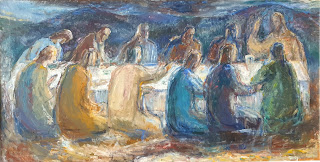Today I gave a talk, with Kathy Rouse, at St Mary with St Leonard Broomfield about the religious art of Rosemary Rutherford.
In my part of the talk I explained that Rosemary Rutherford was part of a generation of innovative female artists whose work is increasingly being rediscovered and re-evaluated. These artists include Vanessa Bell, Hilda Carline, Enid Chadwick, Evelyn Dunbar, Gwen John, Laura Knight, Winifred Knights, Dod Procter, Betty Swanwick and Annie Walke. All of these artists, who challenged the conventions of their day to become respected artists, engaged with religious art or church commissions.
At the beginning of the twentieth century there was also a movement looking for a re-association of the Artist and the Church following the break in that relationship caused by the beginnings of modernism. Laura Knight, Dod Proctor and Annie Walke were involved in a project to decorate St Hilary’s Church near Goldsithney in Cornwall, while Vanessa Bell was part of a project to decorate St Michael and All Angels at Berwick in Sussex. Added impetus was given to this movement following the Second World War as windows and churches needed repair.Artists such as Elizabeth Frink, Henry Moore, John Piper and Graham Sutherland became associated with this development.
Rosemary Rutherford was part of these artistic movements, benefiting from them and making a significant contribution to them. I used the talk as an opportunity to compare and contrast the religious art of Rutherford with others creating work in a similar period. By doing so, I aimed to identify some of the strengths of Rutherford’s contribution and some of the shared emphases of the movements of which she was part.
I ended the talk by saying that religious and biblical art was a significant part of Rosemary’s oeuvre, as would be expected of an artist who was deeply religious. Her spirituality and her inspiration as an artist were very much in harmony leading her to create profound, compelling and often original depictions of Biblical scenes and stories. Her expressive approach means that her images have both emotional impact and spiritual depth. However, her religious paintings are by no means as well known as her stained glass. They are often in private hands rather than public collections and, in some cases, as with St Paul’s Clacton, who have a marvellous collection of works, there is not the space to display them. McVitie Weston, who support this series, also have a substantive holding of Rosemary’s religious art.








No comments:
Post a Comment